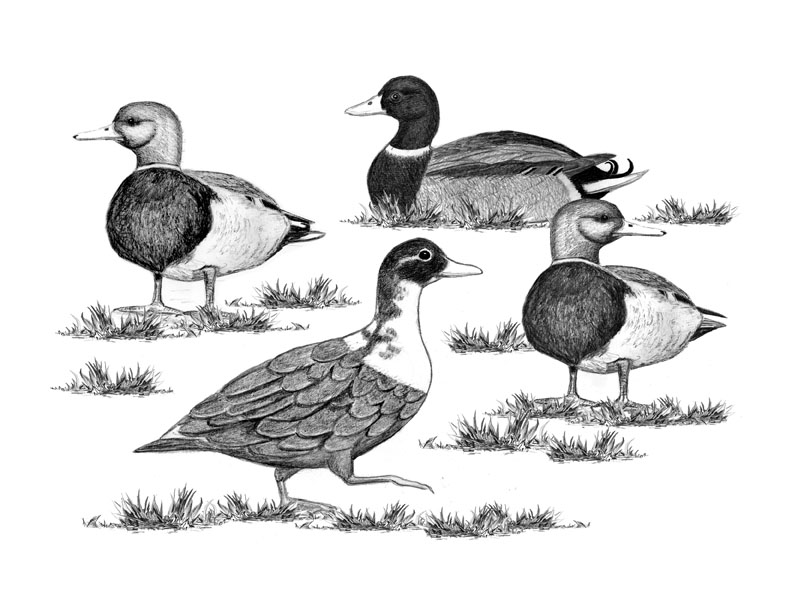
Dear Bird Folks,
Could you please identify the duck in this photo? It arrived on a local pond in early December and it (we call it “Oscar”) has been here ever since. We have consulted our bird books but have not been able to come up with an answer.
– Rena, Falmouth, MA
It’s not in there, Rena,
Usually when people tell me that a mystery bird isn’t in their book, I suggest that they keep looking because the bird is most certainly in there. But in this case, you are totally correct. Your duck (aka, Oscar) not only isn’t in your bird book, it’s not in anybody’s book. In all probability, no one else in the world, aside from you, and perhaps a handful of other Falmouthians, has ever seen a bird quite like this. It is truly one of a kind…maybe.
Your duck appears to be a hybrid, but not a half-electric/half-gas, Prius kind of hybrid. It seems to be a cross of two different duck species. How is that possible? Some ducks, particularly the Mallards found in local parks, are notorious cross breeders. Like drunken frat boys, they will mate with anything that comes close. The resulting offspring tend to be freaky looking and show traits of both parents. This is the reason why there is no picture of it in your bird book. Case closed. Or so I thought.
A few days after receiving your photo, I showed it to our staff domestic duck guy, Matt. (Doesn’t every shop have a domestic duck guy?) Some people enjoy dogs and other people enjoy cats (don’t ask me why) but Matt likes ducks, all kinds of ducks. After seeing your photo, Matt had a different interpretation. Instead of Oscar being a hybrid, he thought it was a domestic species called a “Blue Swedish.” What? Blue Swedish? Did he just make that up? Blue Swedish sounds less like a duck and more like the color of the latest Volvo or a defunct nightclub from the 80s. I had my doubts because I couldn’t see a single blue feather on your bird. So, I grabbed my iPad and searched “Blue Swedish” online and…well, what do you know? There is indeed a breed of domestic duck that goes by the name of Blue Swedish. But I still couldn’t see any blue feathers. Who picks these names! (Probably the same person who came up with the name for the Red-bellied Woodpecker.)
Not having much to do today, I decided to read about these not-so-blue ducks. Here’s the scoop. Blue Swedish were first created in the early 1800s. They originated in a region of what is now northeast Germany and southwest Poland. Thus, in addition to not being blue, it appears the ducks aren’t Swedish either. (When will these contradictions end?) Actually, it turns out that Oscar’s relatives are kind of, sort of Swedish. Back in the old days, a small land area, which is now part of both Germany and Poland, actually belonged to Sweden for some reason. This is where these ducks first came from and have been spreading around the world ever since. Exciting, eh? I’ll bet most folks reading this don’t care and I don’t blame them. Matt, on the other hand, will be thrilled when he reads about the origin of the Blue Swedish. He’s a big fan of ancient duck genealogy…if there is such a thing.
This brings up the next question: How did a duck from some weird, antiquated part of Sweden end up in Falmouth? It’s important to remember that these are domesticated birds. The Blue Swedish that are in our country today didn’t accidently fly across the Atlantic. They were likely brought over by an immigrating farmer who refused to leave his native country without taking his favorite ducks along with him. It is said that Blue Swedish make good pets and are good to eat (for people who still do such a thing), but are best suited for small farms or backyards. Unlike the unfortunate Pekin Ducks, which are often jammed into sheds by the thousands, Blue Swedish need to free range. They don’t thrive well in confinement and thus have avoided the sad factory fate of their cousins.
How did this one imported duck find its way to your pond? Since most domestic ducks are poor flyers, it could have escaped through a hole in a fence of a backyard duck pen. Oscar could also be a victim of “duck dumping.” Misguided people sometimes give “cute” ducklings for Easter or birthday gifts. Eventually, the ducklings grow into adult ducks and become too much work. To solve the problem, the owners drop the birds into a nearby pond. This is not only illegal, but it’s bad for both domestic and wild ducks. Domestic birds are poorly equipped for life outside of the pen, plus they could spread poultry diseases to the native ducks. In addition, the released bird might end up mating with a Mallard and produce offspring that don’t look like any ducks in the bird book. (Yes, I’m back to that again.)
From the photo you sent, Rena, I can’t be 100% sure if your bird is an escaped Blue Swedish or is, in fact, some freak duck caused by cross breeding. If you want to know the answer for certain, you’ll have to order one of those Ancestry DNA test kits…the waterfowl edition. In the meantime, the choice is up to you. You can call it either a Blue Swedish or a hybrid; but if I were you, I would just stick with “Oscar.”